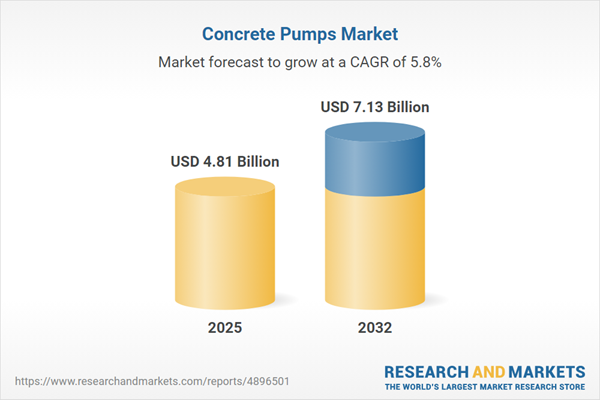Speak directly to the analyst to clarify any post sales queries you may have.
The concrete pumps market is evolving rapidly as senior decision-makers prioritize operational efficiency, regulatory compliance, and resilience amid ongoing construction innovation. Advancements in equipment mobility, automation, and digital integration are central to supporting complex project demands and dynamic supplier landscapes across global markets.
Concrete Pumps Market Snapshot
The global concrete pumps market is experiencing steady growth, driven by strong infrastructure investments from both public and private entities. Ongoing urbanization is raising the bar for performance, with decision-makers seeking solutions suitable for both densely populated cities and remote environments. As project designs and regulatory frameworks increase in complexity, the market rewards reliable equipment and adaptive project planning. Industry leaders are innovating with automation, connectivity, and modularity to help organizations address shifting local preferences while leveraging global operational standards. Technology adoption is being customized regionally, reflecting a broader trend toward digitally managed, compliance-ready assets and strategic procurement models.
Scope & Segmentation of the Concrete Pumps Market
This report delivers actionable intelligence for executives focused on strategic entry, market expansion, or risk mitigation, informed by a comprehensive breakdown of pivotal market segments and technology evolution.
- Pump Types: Boom pumps serve high-demand, complex projects requiring accelerated placement; line pumps offer adaptability for both general and specialty construction activities.
- Mobility Options: Trailer-mounted and truck-mounted models support site accessibility and project versatility, while stationary pumps provide continuous, high-capacity output for major developments.
- Power Source Selections: Diesel-driven units offer dependable performance in demanding and off-grid locations; electric and battery-powered variants are being adopted for sustainability in regulated and urban sites.
- Flow Rate Variations: High-output systems bolster infrastructure and commercial construction, and pumps with adjustable flow rates allow for precise applications in residential or specialty settings.
- Application Segments: Equipment is used across residential, commercial, infrastructure, industrial, tunnel, and bridge projects, each with project-specific requirements and compliance considerations.
- End-User Categories: General contractors rely on robust, efficient operations, while rental providers target equipment adaptability to maximize fleet utilization across project types.
- Regional Coverage: The Americas, Europe, Middle East, Africa, and Asia-Pacific exhibit varied preferences and standards shaped by regulation and differing paces of technology adoption.
- Leading Companies: Prominent organizations include Bobcat Company (Doosan Group), Camfaud Concrete Pumps Ltd, Concord Concrete Pumps Inc, Fangyuan Group, Flowcrete Group, Hyundai Everdigm Corp., Junjin Construction & Robot Co., Ltd., KCP Concrete Pumps Ltd., Liebherr-International Deutschland GmbH, and Sermac Srl.
Key Takeaways for Senior Decision-Makers
- Telematics and advanced fleet management tools enhance project oversight and maintenance, driving process reliability and supporting real-time decision-making in diverse construction environments.
- Electric and battery-powered pumps enable organizations to address stringent regulations and manage emissions, particularly in urban or sustainability-focused project areas.
- Automation and modular design elements improve jobsite safety and provide flexibility, allowing organizations to align with evolving regulatory and operational needs.
- Localized and diversified supply strategies fortify resilience, reducing dependencies on global supply chains and adapting to region-specific regulatory challenges.
- Integration of digital platforms for scheduling and maintenance extends equipment lifecycles and optimizes asset productivity for both contractors and rental specialists.
- Strategic alliances with technology solution providers support digital transformation, optimizing the entire project lifecycle from planning to asset management.
Tariff Impact on Concrete Pumps Supply Chains
With US tariffs targeting select concrete pump components from 2025, companies are reassessing sourcing strategies to ensure uninterrupted supply and regulatory compliance. Large-scale organizations are evaluating options such as local and nearshore suppliers, emphasizing the importance of robust supplier vetting and agile inventory management in an environment influenced by shifting trade policies.
Methodology & Data Sources
This report synthesizes primary and secondary research, drawing on industry journals, technical reviews, executive interviews, and sector-specific surveys. These data sources inform a comprehensive perspective on emerging operational challenges, procurement trends, and regulatory demands in the concrete pumps market.
Why This Report Matters
- Empowers business leaders to implement technology and compliance initiatives that enhance efficiency and long-term value creation within construction programs.
- Supports procurement and supply chain executives in navigating supply complexities as regulatory and trade frameworks evolve globally.
- Functions as a benchmarking tool to develop robust operational models under diverse market conditions.
Conclusion
Senior leaders gain clarity to anticipate market shifts, refine project strategies, and develop resilient strengths in the concrete pumps sector, positioning their organizations for sustainable performance.
Additional Product Information:
- Purchase of this report includes 1 year online access with quarterly updates.
- This report can be updated on request. Please contact our Customer Experience team using the Ask a Question widget on our website.
Table of Contents
3. Executive Summary
4. Market Overview
7. Cumulative Impact of Artificial Intelligence 2025
Companies Mentioned
The companies profiled in this Concrete Pumps market report include:- Bobcat Company by Doosan Group
- Camfaud Concrete Pumps Ltd
- Concord Concrete Pumps Inc
- Fangyuan Group
- Flowcrete Group
- Hyundai Everdigm Corp.
- Junjin Construction & Robot Co., Ltd.
- KCP Concrete Pumps Ltd.
- Liebherr-International Deutschland GmbH
- Sermac Srl
Table Information
| Report Attribute | Details |
|---|---|
| No. of Pages | 197 |
| Published | November 2025 |
| Forecast Period | 2025 - 2032 |
| Estimated Market Value ( USD | $ 4.81 Billion |
| Forecasted Market Value ( USD | $ 7.13 Billion |
| Compound Annual Growth Rate | 5.8% |
| Regions Covered | Global |
| No. of Companies Mentioned | 11 |









